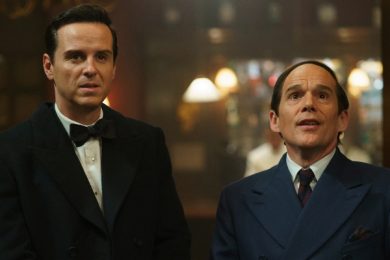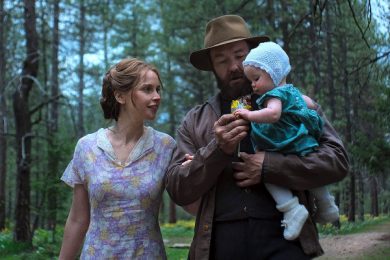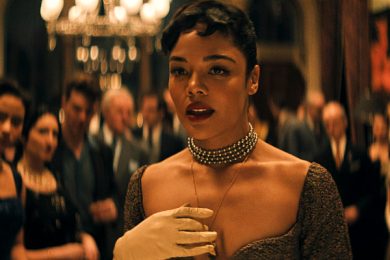Not since Terrence Mallick’s The Tree of Life have I come across a film like Nickel Boys – a movie that is so unlike anything that I’ve ever seen before while taking the care and patience to make sure each image is immaculate. This is director RaMell Ross’s second feature film. The first was a seventy-six minute documentary named Hale County This Morning, This Evening, a contemplative montage within a black Alabama neighborhood which approached its subjects with poetic grace and stark intimacy. There’s a little bit of cinema verité in his work, but he also has a knack for craft. His two films study the connection between subject and process, and in Nickel Boys, that becomes a fusion, making the camera one with our protagonists.
The film is based on the Colson Whitehead novel The Nickel Boys, which itself is inspired by real events. Whitehead is one of our most celebrated contemporary authors and his direct, impassioned prose sometimes feels too ardent for adaptation. Barry Jenkins made a mini-series of The Underground Railroad, and its unflinching views of slavery era America kept a lot of viewers away. There’s not a lot – if any – on screen violence in Nickel Boys, but that’s not because Ross is trying to hide the pain of his characters or assuage his audience. The film is mostly shot from the first person perspective of Elwood Curtis (Ethan Herisse), an intelligent, soft-spoken young man living in Tallahassee, with plans to go to college. After unwittingly accepting a ride in a stolen car, Elwood’s dreams are dashed and he is thrown into the notoriously draconian Nickel Academy.
Nickel is a reform school for boys which believes in rehabilitation by force. There are two wings: one for the white boys, where they’re allowed to play football and get marginally edible food; and one for Black boys, where the living conditions are dire and the punishment for bad behavior is extreme and physical. Despite his sensitive demeanor, Elwood is not meek, and he recognizes that the treatment of the boys at Nickel is barbarian, illegal even. This catches the attention of Turner (Brandon Wilson), another boy in the Black wing of Nickel. The two become fast friends, and as this occurs, the film makes a radical transition and takes the first-person perspective of Turner. As the film proceeds, we switch back and forth, always from one of their points of view, each vantage point illuminating the scenes in different ways.
In most films that shoot from the first person perspective – Hardcore Henry or Enter the Void, to name a couple – the conceit rarely rises above a gimmick, even if it is particularly artful. In Nickel Boys, Ross takes the audacious visual concept and crafts something wholly original, in part by finding the moments when separating from the concept packs a massive emotional punch. It would be so easy for this film to be impenetrable, a feel bad art house film about American racism and systemic injustice. This movie is that in parts but it does not let the pain of its characters define them. Sure, this is about how perspective defines our lives, but in several moments Ross moves the camera in ways that you would not expect – creating an experience more immersive than any IMAX or 4DX film I’ve ever seen.
Ross and editor Nicholas Monsour cut the film in a montage style similar to Hale County. Sequences are clipped to feel like dangled memories, highlighting both the impermanence of life’s tragedies and the fleeting nature of our triumphs. Intercut are clips from the period – Civil Rights era – including home videos from Black families of the time, segments from speeches of Martin Luther King Jr. The movie’s rigorous aesthetic may require adjustments for those unused to Ross’s exploratory style, but this movie is much more approachable than its visual style might initially lead you to believe. Ross keeps us well connected to Elwood and Turner, two boys victims to a system rigged against them. Their connection provides a light within the darkness. A darkness that takes the form of various Nickel Academy functionaries, played by Hamish Linklater, Fred Heschinger, and Gralen Bryant Banks.
At the very least, Elwood has his grandmother, Hattie (an incredible Aujenue Ellis-Taylor), who raised him well and attempts to hire a lawyer to help him gain release. Turner doesn’t have the benefit of family, and outside of Elwood, his “friends” are limited to the tense interactions with other, more hostile Nickel boys (played by an ensemble of Luke Tennie, Ja’Quan Monroe-Henderson, Bryant Tardy, and Trey Perkins, among others). Their relationship is similar to other prison films. A vibrant newcomer comes and revitalizes the faith of an institutionalized veteran. Of course, in all those previous films (Cool Hand Luke, Shawshank Redemption), the tragedy is watching the spirit of the newcomer become ground down, undone meticulously by a punisher who also finds himself inspired by resistance.
This is at times a very sad movie, and that’s by design. Ross’s extraordinary vision doesn’t mean that he’s willing to sell out Whitehead’s determined story, but that he’s able to create such an original film language to tell these boys’ story feels like something close to a miracle. Cinematographer Jomo Fray so expertly renders Ross’s vision. Most first-person films start at a disadvantage, because it’s nearly impossible to create beautiful imagery from that style, but Fray rises to the occasion. There isn’t a single shot from this movie that doesn’t feel thoroughly considered and perfectly executed. When you aren’t hypnotized by a shot’s incredible composition, then you are walloped by the ways in which Ross frames them to maximize emotional impact. This is not a movie that sacrifices its narrative effect for visual innovation, and it manages both better than any film of of the year.
This is, matter-of-factly, a film that changes what you think is possible at the movies. Ross’s ambition is limitless and so is his respect for Whitehead and his characters. Like the book, you spend a good deal of the story bracing for tragedy. In the novel, Whitehead brilliantly colors his ending with a melancholy introspection tinged with ascendancy. It’s the kind of thing that seems impossible to adapt into film, but Ross figures out how, giving us a conclusion that expresses the wide spectrum of emotions both we and the characters feel. One hopes that Ethan Herisse, Brandon Wilson, and Aujenue Ellis-Taylor get proper recognition for their phenomenal performances amongst Ross’s undoubted achievement. And make no mistake, Ross’s achievement is major – a titanic announcement of cinematic excellence.
Directed by RaMell Ross










